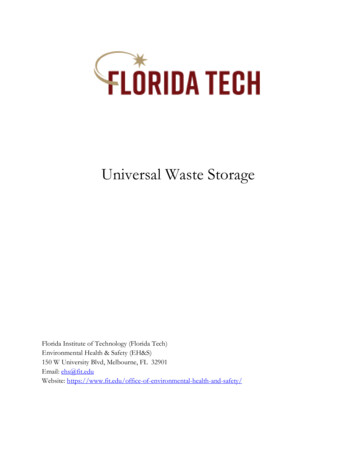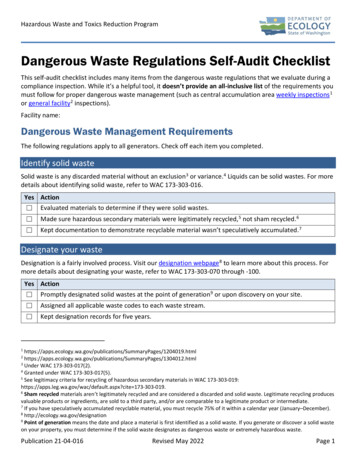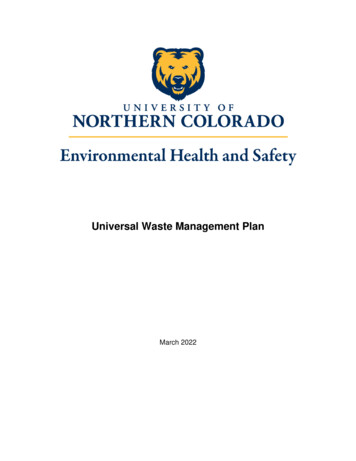
Transcription
Universal Waste StorageFlorida Institute of Technology (Florida Tech)Environmental Health & Safety (EH&S)150 W University Blvd, Melbourne, FL 32901Email: ehs@fit.eduWebsite: -and-safety/
REVISION edDescription of ChangeByCarolyn Martinsen Initial plan creation and implementation.2
ContentsIntroduction . 4Responsibilities . 4Environmental Health and Safety . 4Facilities . 4Definitions . 4Types Of Universal Waste . 5Lamps . 5Compact fluorescent . 5High Intensity Discharge (HID). 62-Foot/ U-Tube Lamps . 66-Foot/ 8-Foot Lamps. 64-Foot Lamps . 6Pesticides . 6Aerosol Cans . 6Batteries . 7Lead Acid Batteries . 7Lithium-ion Batteries. 7Nickel-Cadmium Batteries. 7Alkaline Batteries . 7Universal Waste Storage . 7Choosing a Container. 7Labeling . 8Storing Containers . 8Inspections . 8Appendix A: Labels .10Attachement A: “H” Tape Pattern .11Attachment B: Signature Page.123
INTRODUCTIONThe Environmental Protection Agency’s (EPA) universal waste regulations streamline the hazardouswaste management standards for certain categories of hazardous waste that are commonly generatedby a wide variety of establishments. The streamlined regulations: promote the collection and recycling of universal waste, ease the regulatory burden on retail stores and other generators that wish to collect thesewastes and transporters of these wastes, and encourage the development of municipal and commercial programs to reduce the quantity ofthese wastes going to municipal solid waste landfills or combustors.The federal universal waste regulations are found in Title 40 of the Code of Federal Regulations(CFR) in part 273 and apply to four types of universal waste: Batteries Pesticides Mercury-Containing Equipment LampsThe universal waste regulations require the materials be managed in a way to prevent releases to theenvironment and tailors those requirements to each type of universal waste. The standards alsoinclude labeling, a requirement to respond to releases, and transport to a facility that is permitted orotherwise designated for receiving hazardous wasteRESPONSIBILITIESEnvironmental Health and SafetyPerform weekly inspections to ensure storage compliance. Maintain records of inspections for threeyears. Schedule waste pickups through an approved vendor.FacilitiesCollect and store universal waste in accordance with this plan and federal and state regulations.DEFINITIONSDepartment of Transportation (DOT)The department of the U.S. federal government that coordinates and institutes nationaltransportation programs.4
Environmental Protection Agency (EPA)An independent federal agency, created in 1970, that sets and enforces rules and standards thatprotect the environment and control pollution.Main Accumulation AreaIt is the area, or areas, at the facility of a hazardous waste generator where hazardous wasteaccumulates if it meets the conditions for the accumulation of hazardous waste as defined by theEnvironmental Protection Agency.Universal WasteUniversal waste is a category of waste materials designated as "hazardous waste” but containingmaterials that are very common. It is defined in 40 C.F.R. 273.9, by the United States EnvironmentalProtection Agency.TYPES OF UNIVERSAL WASTELampsWhenever possible, the original manufacture’s packaging should be used to store waste lamps. Thisis beneficial for several reasons. First, the original packaging was designed specifically for itscontents. Second, the packaging meets the Department of Transportation (DOT) shippingrequirements and, third, the packaging is available at no additional cost. When manufacturer’spackaging is not available, an appropriate drum or box should be used. Before starting a newcontainer, check that all existing containers are full.All containers must be labeled with the phrase “Universal waste- lamp(s)” and a start date. Forbetter organization and housekeeping, containers should also be labeled with the contents. Do notwrite directly on drums; use the labels provided. Contact hazwaste@fit.edu to request additionallabels.All lamps should be sorted and packaged according to type.Compact fluorescentAccumulate compact fluorescent lamps in a 55-gallon drum. Label with the phrase “Universal wasteLamp(s)” and the start date5
High Intensity Discharge (HID)Accumulate HID lamps in a 55-gallon drum. Label with the phrase “Universal waste- Lamp(s) andthe start date2-Foot/ U-Tube Lamps2-foot and u-tube lamps should be stored in a 30-gallon drum whenever a manufacturer’s box is notavailable. The container should be labeled with the phrase “Universal waste- Lamp(s) and the startdate6-Foot/ 8-Foot Lamps6-foot and 8-foot lamps should be stored in an 8-foot box. The box should be assembled using the“H” tape method, see attachment A, at the base. The top flaps may be folded or taped shut whilelamps are being accumulated. Once the box is full, the top should be sealed using the “h” tapemethod as well. The box should be labeled with the phrase “Universal waste- Lamp(s)” and the startdate.4-Foot LampsThe order of preference of method for accumulating and storing 4-foot lamps are as follows:1. Original packaging. Whenever possible, the original packaging should be used. The packagemust be intact.2. Four-foot fiber drums.3. Four-foot lamp boxes. May be used when available, boxes should be assembled and sealedusing the “H” tape method, see Attachment A.All 4-foot lamp containers should be labeled with the phrase ““Universal waste- Lamp(s)” and thestart date.PesticidesContact hazwaste@fit.edu for pesticide storage.Aerosol CansAerosol cans, whether empty or not, must be disposed of in a metal 55-gallon drum labeled with thephrase “Universal waste- aerosol cans” and the start date.6
BatteriesBatteries must be removed from any housing; any wires must be removed and disposed of throughthe property department as electronic waste. Batteries must then be sorted and packaged by type.Lead Acid BatteriesAll terminals on lead acid batteries must be protected from discharge. This can be accomplished bytaping over the terminals on the batteries. Lead acid batteries should be accumulated in a 30-gallondrum and label with the phrase “Universal waste- battery(ies)” and the start date.Lithium-ion BatteriesAll terminals on lithium-ion batteries must be protected from discharge. This can be accomplishedby taping over the terminals on the batteries. Accumulate lithium ion batteries in a 15-gallon drumlabeled with the phrase “Universal waste- battery(ies)” and the start date.Nickel-Cadmium BatteriesAccumulate nickel-cadmium batteries in a 15-gallon drum labeled with the phrase “Universal wastebattery(ies)” and the start date.Alkaline BatteriesAlkaline batteries are not hazardous waste and may be disposed of in the trash.UNIVERSAL WASTE STORAGEChoosing a ContainerThe Universal waste storage shed also serves as storage for the department of Environmental Healthand Safety (EHS). EHS stores DOT rated shipping containers for the shipment of hazardouswastes. Please keep this in mind when using containers.Universal waste may be stored for up to a year, so when choosing containers, consider how much ofa waste stream we can accumulate in that time frame. For example, use a 55-gallon drum forcompact fluorescent lamps instead of three 15-gallon containers. Fill all drums completely beforestarting a new container.7
All containers must be compatible with their contents. Both fiber and metal drums are available foruse; metal drums must be used to store aerosol cans. When cardboard boxes are used for lamps,they must be assembled properly to prevent leakage. See Attachment A, “H” Tape Assembly.LabelingAll containers must be labeled with a start date and the words “Universal waste-” followed by thetype of waste, see Types Of Universal Waste section for specific labeling instructions. Labels areprovided by EHS, contact hazwaste@fit.edu to request additional labels. See Appendix A: Labels,for examples. Please use labels provided as they contain the required labeling information and donot write on the container itself. To promote better housekeeping, the contents of the containershould also be written on the label. Labels must be firmly affixed to packaging; use clear packingtape to reinforce labels, when necessary. Drums may be marked full when applicable, by writing acapital F within a circle on the label: F.Storing ContainersContainers must be kept closed except when actively adding waste. Box tops must be taped shut,and drums must be locked shut using the appropriate drum ring. Containers must be stored in anorganized fashion to provide adequate aisle space to allow for inspection. Containers cannot showany signs of leakage or damage. Any compromised containers must be replaced. Any spills should becleaned using the appropriate spill kit. Broken lamps should be vacuumed, and the contents addedto the broken lamp drum.INSPECTIONSPer federal regulations, inspections of the universal waste storage shed are to be performed weekly.Currently, the EHS department performs and documents these inspections. The following list is asummary of inspection points. Containers are in good condition and are structurally sound No signs of leakage or broken lamps Adequate aisle space between containers Containers start dates within past 365 days All containers are closed Incompatible wastes are separated Aerosol cans are protected from source of heat Labels contain a start date Labels are firmly affixed to the container Containers are labeled with the appropriate “universal waste” phrasing Communication device available8
Safety shower and eyewash are operationalStorage area is locked when unattendedSpill kit is stocked and readily availableFailure to meet any of these conditions is considered a violation and results in a failed inspection.Violations found during formal inspections by the EPA result in fines to the University.9
APPENDIX A: LABELSUNIVERSAL WASTEAerosol Cans(s)Start Date:UNIVERSAL WASTEBattery(ies)Start Date:UNIVERSAL WASTELamp(s)Start Date:10
ATTACHEMENT A: “H” TAPE PATTERN1. Fold opposing box flaps down2. Tape down the center seam, securing flaps, using clear packing tape3. Seal open seams with clear packing tape, creating an “H” pattern.11
ATTACHMENT B: SIGNATURE PAGEBy Signing below, I certify that I have fully read and understand the information provided inFlorida Institute of Technology’s Universal Waste Storage Plan.Name (Last, First)SignatureID NumberName (Last, First)SignatureID NumberName (Last, First)SignatureID NumberName (Last, First)SignatureID NumberName (Last, First)SignatureID NumberName (Last, First)SignatureID NumberName (Last, First)SignatureID NumberName (Last, First)SignatureID NumberName (Last, First)SignatureID NumberName (Last, First)SignatureID NumberName (Last, First)Signature12ID Number
All 4-foot lamp containers should be labeled with the phrase ""Universal waste- Lamp(s)" and the start date. Pesticides . Contact . hazwaste@fit.edu for pesticide storage. Aerosol Cans . Aerosol cans, whether empty or not, must be disposed of in a metal 55-gallon drum labeled with the phrase "Universal waste - aerosol cans" and the .










